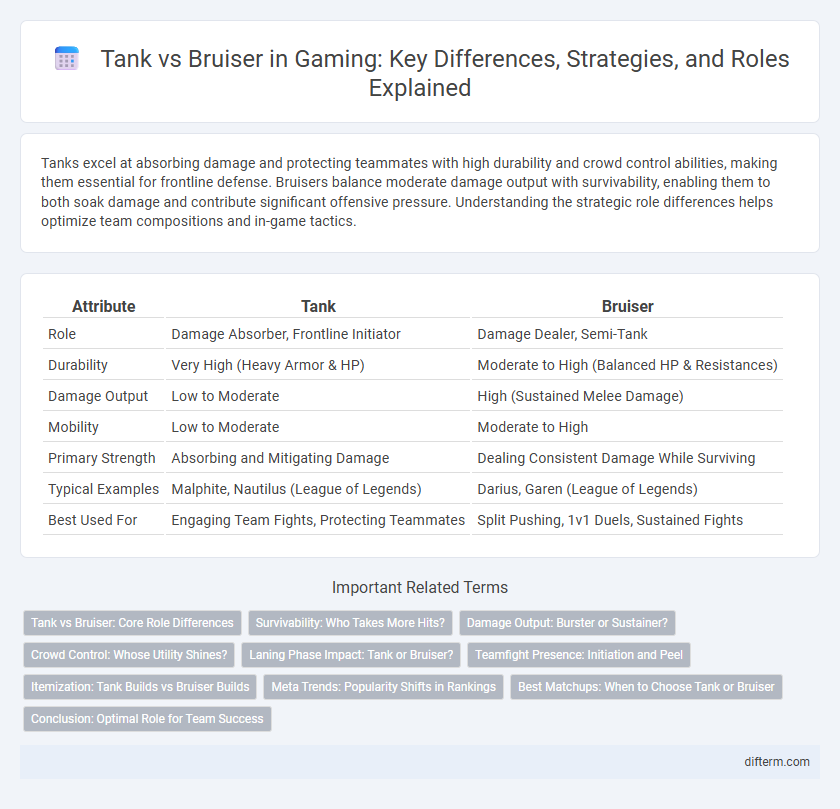Tanks excel at absorbing damage and protecting teammates with high durability and crowd control abilities, making them essential for frontline defense. Bruisers balance moderate damage output with survivability, enabling them to both soak damage and contribute significant offensive pressure. Understanding the strategic role differences helps optimize team compositions and in-game tactics.
Table of Comparison
| Attribute | Tank | Bruiser |
|---|---|---|
| Role | Damage Absorber, Frontline Initiator | Damage Dealer, Semi-Tank |
| Durability | Very High (Heavy Armor & HP) | Moderate to High (Balanced HP & Resistances) |
| Damage Output | Low to Moderate | High (Sustained Melee Damage) |
| Mobility | Low to Moderate | Moderate to High |
| Primary Strength | Absorbing and Mitigating Damage | Dealing Consistent Damage While Surviving |
| Typical Examples | Malphite, Nautilus (League of Legends) | Darius, Garen (League of Legends) |
| Best Used For | Engaging Team Fights, Protecting Teammates | Split Pushing, 1v1 Duels, Sustained Fights |
Tank vs Bruiser: Core Role Differences
Tanks excel in absorbing damage and initiating team fights with crowd control abilities, prioritizing high durability and protection for allies. Bruisers balance offensive power and survivability, dealing sustained damage while maintaining moderate resilience to adapt to both frontline and damage-dealing roles. The core difference lies in tanks focusing on defense and disruption, whereas bruisers blend aggression with durability for versatile gameplay impact.
Survivability: Who Takes More Hits?
Tanks generally take more hits compared to bruisers due to their high base health, armor, and magic resistance, designed to absorb damage and protect teammates. Bruisers balance survivability with damage output, featuring moderate durability but relying on sustain abilities and lifesteal to endure fights. In prolonged engagements, tanks maintain frontline presence longer, while bruisers depend on mobility and regeneration to survive bursts.
Damage Output: Burster or Sustainer?
Bruisers excel at sustained damage output, combining moderate burst with continuous damage over time that excels in prolonged fights. Tanks typically deal lower damage as their primary role focuses on absorbing damage and crowd control rather than burst or sustained offense. In scenarios demanding high immediate burst damage, bruisers outperform tanks, while tanks provide consistent pressure in extended engagements without prioritizing raw damage output.
Crowd Control: Whose Utility Shines?
Tanks excel in crowd control with their high-duration stuns, taunts, and slows that dictate team fights and protect allies effectively. Bruisers offer more versatile crowd control by combining moderate disables with high damage output, enabling them to disrupt enemies while sustaining in the frontline. Tanks' utility shines in coordinating team strategy and initiating fights, whereas bruisers provide flexible crowd control that balances offense and defense.
Laning Phase Impact: Tank or Bruiser?
Bruisers dominate the laning phase by leveraging their balanced mix of damage and survivability to exert pressure and secure kills. Tanks excel at controlling the lane through crowd control and damage mitigation, enabling safer farming and zoning enemies. Choosing between a tank or bruiser depends on lane matchups and team strategy, as aggressive lane control favors bruisers while sustaining presence relies on tanks.
Teamfight Presence: Initiation and Peel
Tanks excel in teamfight presence by providing strong initiation through crowd control abilities and high durability, enabling them to absorb damage and disrupt enemy formations effectively. Bruisers contribute by offering moderate initiation with mobility and sustained damage while excelling at peeling for key teammates through crowd control and repositioning tools. The synergy between a tank's frontline disruption and a bruiser's protective peel enhances overall teamfight stability and control.
Itemization: Tank Builds vs Bruiser Builds
Tank builds prioritize high durability through items like Sunfire Aegis, Thornmail, and Spirit Visage, emphasizing health, armor, and magic resist to absorb damage in team fights. Bruiser builds balance offense and defense with items such as Black Cleaver, Death's Dance, and Sterak's Gage, offering moderate survivability alongside sustained damage output. Efficient itemization for tanks maximizes crowd control and damage mitigation, while bruiser builds optimize for mobility and consistent damage while remaining tanky enough to survive.
Meta Trends: Popularity Shifts in Rankings
Meta trends in gaming show a notable shift in popularity rankings, with bruisers increasingly outpacing tanks in competitive play due to their balanced mix of damage and survivability. Data from recent patches highlight bruisers dominating top-tier matches, reflecting a meta that favors aggressive playstyles and sustained damage output over pure tankiness. This shift influences team compositions and hero prioritization, prompting players to adapt strategies for optimal performance in high-rank environments.
Best Matchups: When to Choose Tank or Bruiser
Tanks excel in matchups requiring high crowd control and sustained frontline durability, especially against teams with multiple bursts of AoE damage or heavy initiation, making them ideal for protecting fragile teammates. Bruisers thrive in scenarios demanding balanced damage output and survivability, particularly effective against squishy opponents or when split-pushing, as their mobility and sustained damage can outperform tanks in skirmishes. Choosing between tank or bruiser primarily depends on team composition, enemy threat profiles, and the preferred playstyle, where tanks anchor fights and bruisers pressure objectives and flanks.
Conclusion: Optimal Role for Team Success
Tanks excel in initiating fights and absorbing damage, providing critical crowd control and protection for the team, which is essential for maintaining frontline stability. Bruisers balance offense and defense with high sustain and damage output, making them ideal for flexible engagements and split-pushing strategies. The optimal role depends on team composition and objectives, with tanks favored for coordinated, teamfight-heavy play and bruisers excelling in skirmishes and objective control.
tank vs bruiser Infographic

 difterm.com
difterm.com